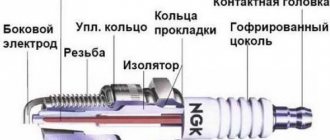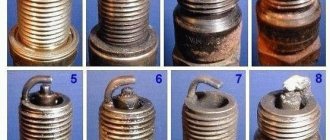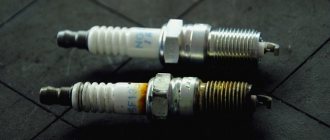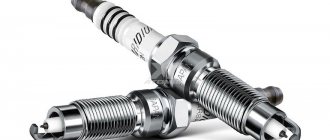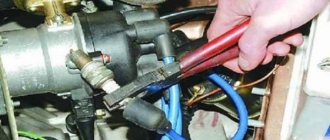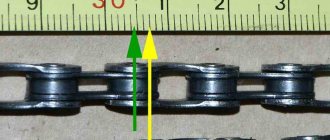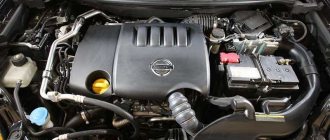Purpose and principle of operation
The purpose of engine spark plugs is to form a spark that ignites the fuel. The elements of the spark plug are subject to high loads, and they are also under the aggressive influence of chemicals formed as a result of incomplete combustion of fuel. The temperature that the parts have to withstand ranges from 70 to 1.2 thousand degrees, and the gas pressure can reach 60 bar.
Important
The design of the candle, as well as the materials used in its manufacturing process, must be as strong, reliable, wear-resistant as possible, and at the same time have stable performance characteristics.
The ability of the spark plugs to uninterruptedly perform their functions determines such characteristics of the engine as its power, starting qualities, fuel efficiency, as well as the composition of the exhaust gases.
As mentioned above, the purpose of a candle is to create a spark and to maintain this spark for a certain time. To cope with the task, it is important that the low voltage from the battery is converted into a high voltage, sometimes reaching 40 thousand V. This conversion occurs in the coil, after which it is transmitted to the electrodes of the spark plug (there is a gap between them).
One of the electrodes (central) receives a “plus”, while the “minus” goes to the side. When a voltage is generated on the electrodes sufficient to overcome the resistance present in the gap (experts call this a breakdown), a spark appears.
After what mileage should you change spark plugs?
These values may vary. Their changes are influenced by the quality of the fuel and the condition of the car itself. In cases of regular use of low-quality fuel, the electrodes in the spark plugs may burn out much earlier than their standard life. Symptoms of this are: unstable engine functioning and loss of traction.
If the car runs on simple spark plugs, and the mileage is already close to 80,000 km, the car’s power decreases and its gluttony increases. This is how many km you need to change the spark plugs. And then the driver may come back to haunt him for his forgetfulness or inattention, since such spark plugs had to be replaced about 60,00 km ago. Although it is not uncommon for ordinary cars to operate stably for 30 and 40 thousand km. But it’s better not to tempt fate and make a replacement according to the procedures, focusing on the potential assigned by the manufacturer. The interval after which spark plugs need to be changed is always indicated on the packaging.
Spark plug malfunctions: what causes them
Spark plugs break quite often, but in fairness, we note that recently, thanks to improvements in manufacturing technology, the service life of parts has increased compared to analogues produced 30 years ago. The most common component failures include:
- Formation of carbon deposits on the electrodes and the top of the insulator.
- Reducing the gap and its contamination.
- The appearance of cracks in the insulator.
- Depressurization.
The fact that the spark plugs have failed is indicated by problems with starting the engine, its uneven operation and a sudden stop.
Depending on the nature of the breakdown, various factors can lead to its occurrence. If the electrode and the part itself are covered with soot, there is a possibility that the mixture in the chamber is incorrect, in particular, there is too much oxygen in it. Such deposits can also be caused by a dirty air filter that requires replacement, malfunctions in the injection system, etc.
When oily deposits appear on the spark plug, it means there is too much oil in the combustion chamber, which indicates wear on the pistons and rings, valves and cylinders. In cars with a turbo engine, such a malfunction becomes a consequence of the failure of the turbocharger.
How many spark plugs are there in a car?
Four-cylinder engine or how many spark plugs are there in a car? This is the kind of unusual article we will look at today in this section. The question is simple to the point of impossible, but many are lost in the answer and begin to get confused, especially young and inexperienced drivers. In old-style cars, everything is simple and clear, but modern ones can bring surprises.
In addition, we should not forget about non-standard configurations and tuned versions, which are assembled in single versions and are intended for specific races or competitions, in other words, they do not have the status of a serial car. Let's look at how to determine the quantity and where they are located below.
How many spark plugs are there in a car? First you need to decide on the number of cylinders, so this figure will be the starting point. As a rule, passenger cars have a four-cylinder engine, so there will be only 4 spark plugs. Non-standard configurations like OKA, then there are 2, since the engine is two-cylinder, some BMW models have 6.
The main advantage of this quantity is the longevity of the car.
For racing cars, a spark plug has been developed without a side electrode, the replacement of which is the spark plug body. The mechanism has proven itself on the positive side and similar samples may soon be introduced into mass production.
We hope our recommendation article on the topic of how many spark plugs are in a car, as well as their characteristics, will help you when carrying out preventive and diagnostic repairs.
Spark plug
Spark plugs play one of the most important roles in the operation of an internal combustion engine. The power of the power unit and the efficiency of a diesel or LPG installation depend on them. Today we will tell you everything about spark plugs: their parameters, design, service life and inspection interval during maintenance.
Purpose
Any internal combustion engine, regardless of what fuel source it has, is designed almost the same. Even the installation of gas equipment practically does not change the operating principle of the internal combustion engine, regardless of its power, volume and other technical characteristics.
To ignite the fuel mixture, which is pumped into the cylinders using an injector or carburetor, so-called spark plugs are provided in the internal combustion engine. Their main task is to take the spark coming from the transformer coil and transmit it through two electrodes directly into the combustion chamber, where the combustion process occurs. Typically, a spark has a power of 20–30 kilovolts, so the fuel literally ignites in the chamber and instantly pushes the piston up, causing the shaft connected to it by a connecting rod to rotate.
The question of how many spark plugs are located in an internal combustion engine is quite simple. The fact is that the internal combustion engine requires one spark plug for each cylinder. How many cylinders - so many spark plugs should be in their seats.
Are there exceptions to this rule? Of course yes. Some internal combustion engines, especially in racing and sports cars, have such a structure that the spark plugs are located on both sides of the same chamber: to get their number, you need to find out how many cylinders are working in the internal combustion engine and multiply this figure by two.
Why is this being done? In order to increase the efficiency of combustion of the fuel mixture in the cylinders and thus greatly increase the power of the internal combustion engine. A special feature of these types of internal combustion engines is that spark plugs are used from special alloys that can withstand significant temperature overloads and also have an increased resource and service life.
It is also worth noting that spark plugs on gasoline and diesel internal combustion engines (in diesel they are called glow plugs) have slightly different structures and operating principles. Spark plugs for gasoline internal combustion engines operate on the principle of spark transmission and have a fairly long resource and service life. On diesel engines, on the contrary, the electrodes operate on the principle of incandescence, and therefore the remaining service life is checked here much more often.
Principle of operation
Plugs are incredibly simple elements, so the design of a spark plug is understandable even to an inexperienced beginner. In order to understand how they function, it is not at all necessary to know dozens of physics formulas and have experience working with complex technical literature and classification tables.
All that is worth remembering: the main feature that determines the resource and service life of the spark plug is the material from which the electrodes are made. However, first it’s worth talking about what components and parts the spark plug consists of, and what the significance of each of the elements is during engine operation.
The main element - the body - is made of hardened steel. This material is able to withstand significant overloads in temperature and pressure and at the same time not affect the resource and service life of the candle for quite a long time. It has a thread on it and is shaped like a hollow cylinder inside. The task of the housing is to combine all the functional elements of the spark plug and ensure a tight and reliable threaded fit in a specially designated place on the cylinder head. For this reason, it is worth paying attention to such a parameter as the diameter of the spark plug.
A lot depends on the diameter. For example, if the diameter of the thread on a spark plug is larger than the size of the hole in the cylinder head, there is every reason to believe that such a spark plug was purchased in vain. It is also worth understanding that if the spark plug is smaller than needed, it may not fit tightly into the thread or simply fall into the engine cavity. This will lead to the need for partial disassembly of the motor, which takes a lot of time and effort from the owner. For convenience, spark plug sizes are always indicated on the packaging.
There is a ceramic seal inside the case. It is not for nothing that ceramics was chosen as the main material for the manufacture of such a part. Such a layer will not accumulate temperature and static electricity due to its special properties. Among other things, this white material is able to perform its functions for a long time, which means good savings and a longer interval for checking the condition of working elements.
The main functional element, which takes on the task of receiving and transmitting a spark and igniting the mixture, is the two electrodes that are located at the top of the spark plug. Spark plugs usually have one central electrode and two side electrodes. Individual spark plugs may have three or even four side electrodes. For what? According to manufacturers, this ensures more uniform spark distribution and greater efficiency of the engine and all its components.
Service
When it comes to spark plug maintenance, there are two things to consider. The first thing to keep in mind is the manufacturer's recommendations. As a rule, the car service book provides the most up-to-date information regarding how often the spark plugs in the car should be replaced and how often their condition should be checked.
The second point is to periodically unscrew the candle and check its color. The color is able to inform the owner about the wear of the car spark plug and the need to replace it as soon as possible. Among other things, it is worth paying attention to the sharp deterioration in the characteristics of the car and its driving qualities. In some cases, the performance deteriorates so much that the car practically stops accelerating or even stalls when the engine has not yet warmed up.
If the changes in the characteristics of the automobile internal combustion engine are unnoticeable, then it is worth unscrewing the spark plug body using a special key and paying attention to the color of the deposit that is present on it. Black coating is especially dangerous, regardless of what type of engine you are dealing with. The thing is that the black coating is formed due to carbon deposits resulting from the combustion of fuel.
If a black coating covers the entire electrode, then the spark power is significantly reduced and the potential of the internal combustion engine drops, and its parts fail prematurely. In addition, this can lead to gradual clogging of the cylinder chambers, which will require the owner to make additional investments in a major overhaul of the engine.
The yellow rings located along the edge of the ceramic insert should also cause the owner some concern and a desire to replace it as soon as possible. The yellow color is due to the fact that a breakdown has already occurred in the cylinder, since an insufficient power spark was produced. In this regard, it is strongly recommended to replace old spark plugs with new ones, the color of which does not differ in any way from snow-white.
Summary
Spark plugs are an extremely important functional element of the internal combustion engine, without which a car engine simply would not work. To free yourself from the need for expensive repairs and maintenance of the cylinder head, as well as cleaning the combustion chambers, it is strongly recommended that you regularly check the condition of the spark plugs. This is not so difficult to do, but it guarantees the absence of any defects in the operation of the car and the risk of breaking down on the road, when maximum reliability is required from the car.
«
Great article 0
How to increase spark plug life
To extend the life of spark plugs, some car enthusiasts use so-called traditional methods; we will describe one of them in more detail.
To ensure safety, you should disconnect the ground or remove the terminal from the battery, disconnect the cables, and remove the spark plugs. Then you need to measure the required length of the side electrode, mark the section to be cut off, and clamp the body of the part to securely fix it, but not damage it. Carefully remove the excess part of the electrode, and process the cut with a file so that there are no burrs.
Using pliers, bend the electrode so that the edge matches the height of the central electrode and the gap matches the nominal value. The described procedure should be repeated on each part, then after modernization, screw them into place and connect them in accordance with the design features of the power plant.
Reasons for their natural and premature wear
p, blockquote 5,0,0,0,0 —>
The spark plug operates under extremely extreme conditions:
p, blockquote 6,0,0,0,0 —>
- high temperature in the working cylinder;
- aggressive environment in the form of a mixture of fuel, air and oil;
- high pressure during ignition;
- high voltage and temperature of electric spark.
adsp-pro-1 —>
The simultaneous action of these factors leads to an intensification of the processes of their natural wear. This process can be significantly accelerated in the following cases:
p, blockquote 7,0,0,0,0 —>
- reduction of compression, wear of valve stem seals due to oil entering the working volume;
- incorrect setting of the ignition angle, leading to the formation of increased carbon deposits;
- choosing spark plugs that do not match the engine brand;
- misfire in cylinders;
- incorrect gasoline/air ratio due to malfunctions of the flow meter, lambda probe, or air leaks;
- incorrect operation of injectors.
Origin of red plaque
This phenomenon is less common than the effects described above. Why are there red electrodes on some spark plugs?
- the tank is filled with low quality gasoline with additives that increase the octane number;
- a car enthusiast or a fuel supplier adds additives to gasoline, which contain a large amount of metals;
- the owner of the car installed spark plugs in the cylinders that did not match the heat rating.
The reasons for the reddish tint of spark plugs do not pose a direct threat to the power unit, but are harmful in the long term. Driving on low-quality gasoline with unknown additives a priori accelerates the wear of parts and components. Plus an increase in consumption arising from worsening combustion conditions of the mixture in the cylinders.
We recommend: Review of the best station wagon models
Operating a car with spark plugs that are “cooler” or “hotter” in terms of heat rating reduces engine power and significantly shortens the life of the elements. A characteristic sign of incorrectly selected spark plugs is a drop in crankshaft speed at idle and missed ignition cycles.
